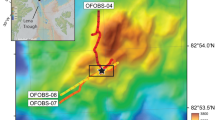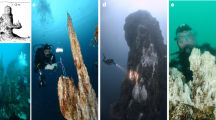Abstract
STUDIES of sea-floor hydrothermal vent fluids have shown them to have stable characteristics on a decade timescale1, with temperatures in the range 350 ± 30 °C (ref. 2) and chemistries2 that vary from vent to vent, which have most recently been interpreted to reflect phase separation within the hydrothermal system3á€-7. Here we report measurements of vent fluid temperature and chemistry from 9° 46.5′ N on the East Pacific Rise, which show unprecedented variability on timescales of only a week. Our measured temperatures range up to 403 °C, placing the fluids unequivocally in the vapour field at the sampling conditions. Consistent with the fluids being in the vapour phase are the lowest chlorinities and silica contents, and highest hydrogen sulphide contents, yet reported for sea-floor vent fluids. These unusual fluid characteristics are the result of a volcanic eruption having occurred at this site, within weeks of when the first measurements were made8. The hydrothermal system in the immediate post-eruptive period is thus characterized by previously unknown temperature and chemical characteristics, necessitating revisions to models of hydrothermal fluxes to the oceans.
This is a preview of subscription content, access via your institution
Access options
Subscribe to this journal
Receive 51 print issues and online access
$199.00 per year
only $3.90 per issue
Buy this article
- Purchase on Springer Link
- Instant access to full article PDF
Prices may be subject to local taxes which are calculated during checkout
Similar content being viewed by others
References
Campbell, A. C. et al. J. geophys. Res. 93, 4537–4549 (1988).
Von Damm, K. L. A. Rev. Earth planet. Sci. 18, 173–204 (1990).
Bischoff, J. L. Science 207, 1465–1469 (1980).
Von Damm, K. L. J. geophys. Res. 93, 4551–4561 (1988).
Massoth, G. J. et al. Nature 340, 702–705 (1989).
Lilley, M. D. et al. Nature 364, 45–48 (1993).
Butterfield, D. A. et al. J. geophys. Res. 99, 9561–9583 (1994).
Rubin, K. H., Macdougall, J. D. & Perfit, M. R. Nature 368, 841–844 (1994).
Haymon, R. M. et al. Earth planet. Sci. Lett. 119, 85–101 (1993).
Fornari, D. J. et al. (abstr.) Eos 71, 621 (1990).
Bischoff, J. L. Am. J. Sci. 291, 309–338 (1991).
Bischoff, J. L. & Rosenbauer, R. J. Earth planet. Sci. Lett. 68, 172–180 (1984).
Shanks, W. C., Böhlke, J. K. & Seal, R. R. in Physical, Chemical, Biological, and Geological Interactions within Hydrothermal Systems Ch. 8 (eds Lupton, J., Mullineaux, L. & Zierenberg, R.) (Monogr., Am. Geophys. Un., Washington DC, 1995).
Von Damm, K. L. et al. Geochim. cosmochim. Acta 49, 2197–2220 (1985).
Von Damm, K. L., Bischoff, J. L. & Rosenbauer, R. J. Am. J. Sci. 291, 977–1007 (1991).
Seyfried, W. E. Jr, Ding, K. & Berndt, M. E. Geochim. cosmochim. Acta 55, 3559–3580 (1991).
Alt, J. C., Laverne, C. & Muehlenbachs, K. Init. Rep. DSDP Leg 83, 217–247 (1984).
Fournier, R. O. Prof. Pap. US geol. Surv. 1350, 1487–1506 (1987).
Kent, G. M., Harding, A. J. & Orcutt, J. A. J. geophys. Res. 98, 13945–13969 (1993).
Harding, A. J., Kent, G. M. & Orcutt, J. A. J. geophys. Res. 98, 13925–13944 (1994).
Rosenberg, N. D., Spera, F. J. & Haymon, R. M. Earth planet. Sci. Lett. 116, 135–153 (1993).
Von Damm, K. L., Oosting, S. E. & Buttermore, L. G. (abstr.) Eos 75, 618 (1994).
Kennedy, G. C. Econ. Geol. 45, 629–653 (1950).
Author information
Authors and Affiliations
Rights and permissions
About this article
Cite this article
Damm, K., Oosting, S., Kozlowski, R. et al. Evolution of East Pacific Rise hydrothermal vent fluids following a volcanic eruption. Nature 375, 47–50 (1995). https://doi.org/10.1038/375047a0
Received:
Accepted:
Issue Date:
DOI: https://doi.org/10.1038/375047a0
This article is cited by
-
Constraining temporal variations in metal and sulfur sources using high-resolution mineral-scale analysis of pyrite: evidence from the Brothers volcano, Kermadec arc, New Zealand
Mineralium Deposita (2023)
-
Diversity of magmatism, hydrothermal processes and microbial interactions at mid-ocean ridges
Nature Reviews Earth & Environment (2022)
-
Mineral-scale variation in the trace metal and sulfur isotope composition of pyrite: implications for metal and sulfur sources in mafic VMS deposits
Mineralium Deposita (2022)
-
Gold and tin mineralisation in the ultramafic-hosted Cheoeum vent field, Central Indian Ridge
Mineralium Deposita (2021)
-
Kolumbo submarine volcano (Greece): An active window into the Aegean subduction system
Scientific Reports (2016)
Comments
By submitting a comment you agree to abide by our Terms and Community Guidelines. If you find something abusive or that does not comply with our terms or guidelines please flag it as inappropriate.



